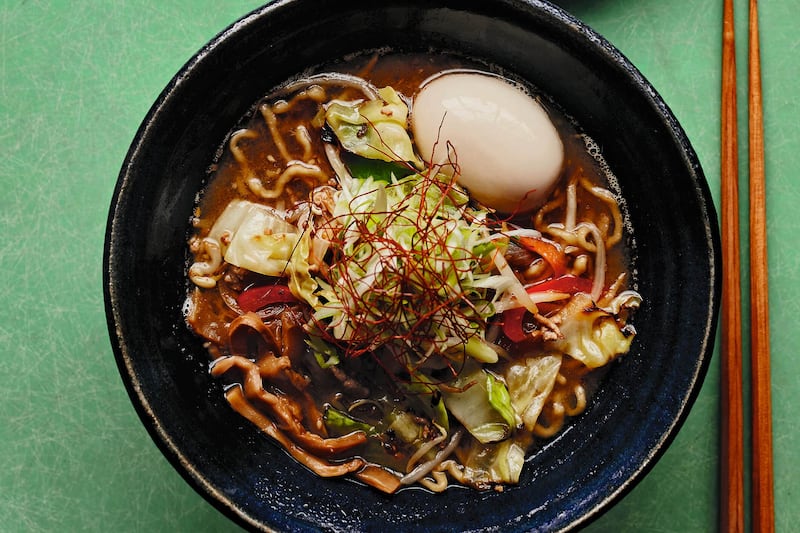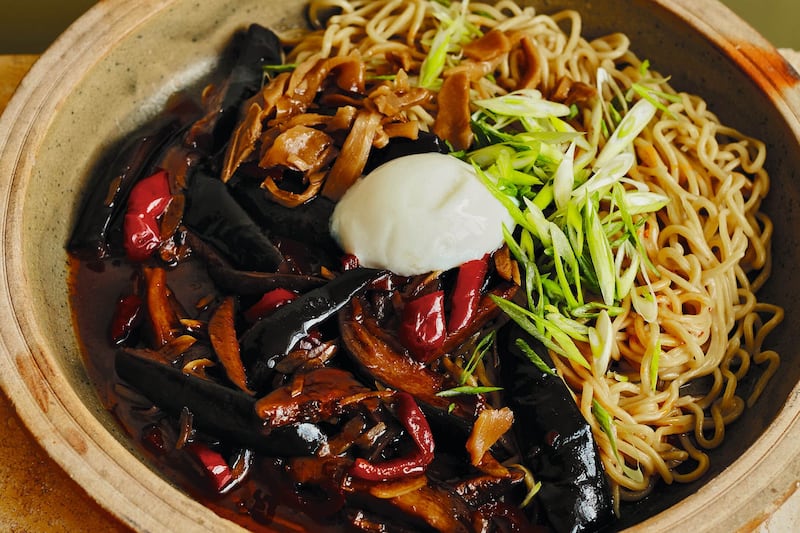YOU'D think ramen wouldn't work without a golden yolked egg, snugly suspended in the rich Japanese broth atop a tangle of noodles.
But slurping up the 'Ramen for Faye Wong' – chef Tim Anderson's edible ode to the vegetarian Chinese actress – it seems you can cope. Quite easily.
There are firm noodles, saffron-style strands of dried chilli, daikon, a bunch of otherworldly enoki mushrooms and a smattering of spring onions in a mushroom dashi that's heady and deep. The egg you forget about. A slab of belly pork you realise could totally knock the balance.
It's a swift lesson in the possibilities Japanese food offers for non-carnivores, which is the topic of Anderson's new cookbook, Vegan Japaneasy.
A follow-up to the Wisconsin-born, London-based 35-year-old's previous recipe collection, Japaneasy, it isn't "strictly for vegans" but does wedge open the door on a cuisine often considered closed to those who steer clear of animal products.
"I'm not a vegan and I'm not trying to make anybody be vegan," notes Anderson, who runs Japanese soul food restaurant Nanban. Meaning if you want to add a gooey ramen egg, no one will stop you, but the idea is to open up Japanese food to all taste buds.
"It was an interesting challenge, but it wasn't a big challenge," he says when pressed on how tricky it was to take traditional Japanese recipes and make them satisfyingly vegan.
What can be hard is actually visiting Japan itself if you're vegan. "Fish is in a lot of things," notes Anderson, plus, "there's funny cultural differences between here and there in terms of what's actually considered meat." You might be presented with a bowl of fish-based dashi, even if you said you're vegetarian. Also, "the word 'meat' is usually thought of as red meat, so chicken could turn up in a vegetarian order."
Then there's the fact "so many restaurants in Japan specialise in just one thing. And that one thing is usually a meat or fish thing." Which means endless restaurants choices for omnivores, but far fewer for those who are plant-based. Yakitori and ramen shops might just be completely off limits, because "if you go to that kind of a restaurant, there aren't options, you get the meat thing, or you get nothing."
Anderson says it can be "tough" (unless you're staying in Japanese Buddhist temples, where cooking is often vegan), but home cooked Japanese food – the kind of fare in Vegan Japaneasy – is a completely different, much more accessible beast. And that's arguably down to Japanese seasonings, "which are so good".
"I realised my own home cooking was skewing more vegetarian, and because I was using delicious Japanese seasonings, you don't miss the meat," says Anderson. Soy sauce, miso, rice vinegar, mirin, sake – "there are just so many great ingredients in Japanese cooking that can be meaty and savoury and satisfying, but without actually containing meat."
And to be clear, Anderson loves meat. "I really, really do," he admits. "But I also love vegetables. I think they're perfectly satisfying – and they're cheap too."
In the book, you'll find carrots turned fudgy with teriyaki sauce, celeriac 'wafu' steaks doused in ginger, onions, soy sauce, rice vinegar and sugar, and egg-free ramen. What you won't find so much of are meat alternatives, like tofu.
"You can't avoid it, and I'm not trying to avoid it," says Anderson, holding his hands up placatingly against an invisible barrage of tofu-related outrage. "It is bland. For me, as a protein, a main thing in a dish, it doesn't really tick the box. It doesn't deliver that satisfaction."
Vegetables though, do. "Vegetables are delicious, in and of themselves." Season them right and you're good to go.
Japan's seasonings prowess Anderson puts down in large part to an accident of the country's climate and environmental DNA. While we "have ketchup" and "have cheese cast as a seasoning", Japan is home to an abundance of seaweeds and mushrooms, soybeans and its national fungus, koji (a mould spore). All of these, he explains, "just so happen to create a huge amount of umami compounds."
At this point, the former MasterChef winner gets "a little bit nerdy" about the "flavour bombs" attainable when you combine umami rich ingredients. They amplify one another, which makes your dinner more aromatic, umami, and delicious. "Everything in Japanese cooking, and all of the seasonings, are about fortifying umami," he buzzes.
Other countries have similar culinary circumstances, like Italy, which Anderson says "in terms of umami for money, that's the best value outside of Japan because they'll combine things like anchovies, Parmesan cheese, and tomatoes". He calls it "another great cuisine for vegans. It's all about umami."
It's also about not taking Japanese food too seriously. "People still think Japanese food has to be perfect and beautiful and made by very skilled craftspeople and artisans and highly trained chefs" – which is only true if you're an actual Japanese chef, says Anderson, but "home cooking doesn't have to be perfect."
:: Vegan Japaneasy by Tim Anderson, photography by Nassima Rothacker, is published by Hardie Grant, priced £22. Below are two recipes from the book for you to try.
VEGAN RAMEN
(Serves 4)
1 pack (300-350g) firm silken tofu, cut into 8 rectangles
2tspb sake
100g cornflour
1tspb black sesame seeds
100ml plus 2tspb vegetable oil
1 sheet of nori, or 1tspb aonori flakes
Big pinch of salt
1.2 litres mushroom dashi (see below)
90ml soy sauce
4tspb mirin
About 1/2 daikon/mooli, peeled and cut into rounds about 2.5cm thick
80-100g enoki or shimeji mushrooms, roots removed and broken into small clusters
1/4 Chinese cabbage, cut into 2.5cm strips
4 portions of uncooked ramen noodles
4 shiitake mushrooms (this is a good use for the rehydrated ones from making dashi), destemmed and thinly sliced
2 spring onions, finely sliced
1/2 mild red chilli, deseeded and very thinly grated (shredded)
A few strips of lemon or yuzu zest
For the mushroom dashi:
(Makes about 350ml, plus the rehydrated mushrooms)
10g kombu (a piece about 10cm square)
15g dried shiitake mushrooms, or 10g dried shiitake plus 5g dried porcini mushrooms
500ml cold water
Method:
For the mushroom dashi: Place the kombu and dried mushrooms in a saucepan with the water and set over a low heat. Slowly bring the water to a very low simmer. Remove from the heat, then leave to infuse for at least 1 hour. Remove the mushrooms and squeeze them out like a sponge, then pass through a sieve (fine-mesh strainer) and store in the refrigerator for up to one week. The mushrooms will keep in the refrigerator for about four days.
Put the tofu into a small bowl and pour the sake over the tofu. Mix together the cornflour and sesame seeds, then carefully dredge the tofu in the cornflour mixture, ensuring it is evenly coated. Heat the two tablespoons of oil in a non-stick frying pan (skillet) over a medium-high heat and cook for a few minutes on each side, until the tofu is golden brown and crisp. Drain on paper towels and set aside.
Puree the 100ml oil, nori and salt together in a food processor until the seaweed is completely pulverised. Leave the oil to settle while you prepare the rest of the dish.
Bring the dashi, soy sauce and mirin to the boil in a saucepan, then add the daikon rounds. Reduce the heat to a high simmer, place a lid on the pan and cook until the daikon are tender, about 10 minutes. Remove the daikon with a slotted spoon and reserve.
If you're using shimeji mushrooms, boil them in the dashi for a couple of minutes, then remove and reserve (the enoki don't need cooking). Keep the dashi at a low simmer with a lid on the pan.
Bring a large pan of water to the boil and blanch the cabbage for one minute, then remove with a slotted spoon and reserve. Let the water come back to the boil and cook the ramen until al dente, according to the packet instructions. Drain very well.
Divide the ramen among four deep bowls, pour over the mushroom dashi and toss the noodles with chopsticks to ensure they aren't stuck together. Top with the cabbage, daikon, mushrooms, tofu, spring onions, chilli shreds and lemon or yuzu zest.
Finally, add a generous spoonful or two of the nori oil to the surface of the broth.
TERIYAKI-ROASTED CARROTS
(Serves 4)
500-600g carrots (I like chantenay carrots for this because I am lazy and they require no prep, but any carrots will do)
2tbsp oil, plus a little extra for greasing
8tbsp Sweet Soy Sauce
Zest of 1/2 orange or lemon
Method:
Preheat the oven to 200C. Line a roasting pan with baking parchment. Toss the carrots in the oil, then use a little more to rub onto the roasting pan or parchment. Spread the carrots out in the pan and roast for 20 minutes (if they're small) or 30 (if they're big).
Pour over six tablespoons of the sweet soy and add the citrus zest, and toss so that all the carrots are evenly coated. Place back in the oven for five to 10 minutes, checking to ensure they aren't burning. The carrots are done when the sauce has reduced to a very thick, dark, sticky glaze that clings to the carrots.
Remove from the oven, add the remaining two tablespoons of sweet soy sauce, and toss. Leave to cool slightly before serving.








